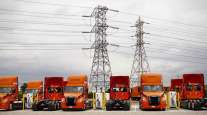Managing Editor, Features and Multimedia
NACFE Releases Report on ‘Messy Middle’ for Decarbonization of Trucking

[Stay on top of transportation news: Get TTNews in your inbox.]
ORLANDO, Fla. — The North American Council for Freight Efficiency has released a new report examining the myriad powertrain decisions trucking companies will face on the industry’s journey toward decarbonization.
The report, dubbed “The Messy Middle: A Time for Action,” examines the long period of transition from today’s diesel-powered trucks to a future state when the industry has fully shifted to zero-emission freight movement.
NACFE introduced the report at a Feb. 26 press conference here at the Technology & Maintenance Council Annual Meeting and Transportation Technology Exhibition.
In the years ahead, fleets will be able to choose from an expanding menu of powertrain options, including advanced diesel trucks, renewable fuels, natural gas, hydrogen combustion engines, hybrids, battery-electric vehicles and hydrogen fuel cells.
The report, which focuses primarily on longhaul Class 8 trucking, analyzes the benefits and challenges of each option and provides a decision-making framework designed to help fleets evaluate their choices during this “messy middle” period.
This time of transition is already under way, said NACFE Executive Director Mike Roeth.
“Trucking is decarbonizing,” he said. “We are doing it in a lot of different ways, from the better efficiency of diesel trucks, going to zero with battery-electric and hydrogen, and finally looking at these alternatives in the messy middle.”

Seger by Anneliese Mahoney/Transport Topics
Jeff Seger, NACFE’s clean energy consultant and the lead author of the report, outlined several key factors that will influence future powertrain decisions, including stricter emission regulations, fuel and energy prices and the push toward environmental sustainability.
“What we’re seeing is the model is clearly changing for fleets,” Seger said.
The old mantra of “get it there on time at lowest cost” is giving way to “get it there on time at lowest cost, but in an environmentally friendly way,” he said.
While diesel remains the industry’s “gold standard” in terms of range, cost and maturity, battery-electric and hydrogen fuel cell trucks represent the best options for environmental sustainability, Seger added.
He also emphasized the importance of considering not only tailpipe emissions but also well-to-wheels sustainability for battery-electric and hydrogen fuel cell vehicles.
NACFE began using the term “messy middle” in 2019 to describe the complexities of the trucking industry’s shift toward zero emissions in the coming years and decades.
“It should not have any negative connotation,” Seger said. “It’s just a period when there are a lot of different options for fleets and a lot of decisions they are going to need to make.”
The report concludes that fleets should begin entering the “messy middle” now to prepare for a zero-emission future.
“This is a time of action,” Roeth said.
That may involve deploying electric vehicles or trucks powered by alternative fuels, but even in cases where diesel remains the most viable option, fleets can still be very aggressive in terms of optimizing fuel efficiency and reducing emissions, he said.
Want more news? Listen to today's daily briefing above or go here for more info
The report also encourages industry stakeholders such as manufacturers, consultants and regulators to support fleets in making the right powertrain adoption decisions for their specific operations.
NACFE said it plans to issue a separate confidence report on natural gas-powered tractors later this year.
The “messy middle” report is available online at nacfe.org/research/thought-leadership.


&uuid=(email))



